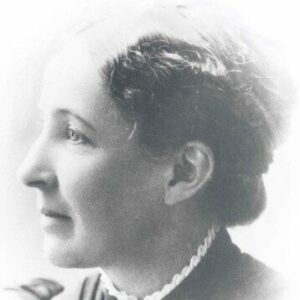Emma Cole
By Julie Stivers, 2007
Emma Jane Cole lived nearly her entire life in Grand Rapids, Michigan, but she pursued her scientific work in botany in travels to Europe, Cuba, Mexico and all over the U.S. She maintained an active correspondence and material exchange with the leading botanists of the era. In 1901, she published Grand Rapids Flora: A Catalogue of the Flowering Plants and Ferns Growing Without Cultivation in the Vicinity of Grand Rapids, Michigan. The book was the first, and remains the only, scientific botanical census of the area, covering more than 600 square miles and documenting more than 1,200 plants. She also served as an inspiration to a large number of young scientists during her 26-year teaching career at Central High School, and on her death left a number of significant bequests to further the study of botany in the city and at The University of Michigan, as well as a large and scientifically important herbarium.
Emma Cole was born in Milan, Ohio and came to Michigan with her family to settle near Lowell. She attended and taught at schools near there, and in 1876 enrolled at Cornell University to study botany. She returned to Grand Rapids to join the faculty at Central High School and taught there until her retirement in 1907.
When Cole came to Central High School in 1881, it was also home to
the Kent Scientific Institute, precursor to today’s Grand Rapids Public Museum. Records of the Museum show that the staff of the Institute served without salary, but in 1892, the Board of Directors voted to pay her to complete the mounting and arranging of botanical materials. She was among the first female members of the Kent Scientific Institute, chair of the Botany Committee, and in 1900 was elected a vice president of the organization.
The commission from the Institute allowed Cole to continue her lifelong devotion to the creation of a substantial herbarium, a collection of pressed and dried plant examples scientifically labeled and organized. When she died in 1910, she left her herbarium to the Kent Scientific Institute’s Museum. According to the KSI Annual Report of 1912, the collection numbered 3,581 completed pages, plus 1,278 unmounted specimens.
The herbarium was the core of the Museum’s natural history collection until the 1930s. It was moved to Aquinas College and used for study there until 1974, when it was put on permanent loan to The University of Michigan Herbarium, one of the finest facilities in the country.
Cole shared her research and corresponded with eminent botanists from around the world. In 1901, her work on the genus Crataegus, or Hawthorn, prompted a visit to Grand Rapids by Charles Sprague Sargent. Director of the Arnold Arboretum at Harvard University for 54 years, beginning with its inception in 1873, Sargent was the recognized authority of his time on North American trees, and produced many important books. As a result of that visit and others, and her research in collecting flowering and fruiting specimens, Sargent credited her help in describing 20 new species, and named one Crataegus coleae, a recognition that has persisted, and it is included in the standard text Gray’s Manual of Botany as “named in 1902 for its discoverer, Emma J. Cole.”
Emma Cole and Charles Sargent corresponded for the rest of her life, and in 1904 she spent the summer at Harvard working at the Arnold Arboretum. She also corresponded extensively with staff at the Gray Herbarium at Harvard, and spent other summers working at Cornell and at the University of California at Berkeley.
Cole’s herbarium is a record of her travels to Europe, the British Isles, Cuba, Mexico, and throughout the U.S. at a time when travel for a single woman could not have been anything but challenging, and of her collaboration with plant experts, almost exclusively male, around the world. She died in 1910, on a plant collecting trip to Mexico. She left bequests that included money for laboratory equipment at Central High School, flower services at area churches that continued until 1967, and an endowment for a botany fellowship at The University of Michigan which is still awarded annually. She is buried in Vergennes Township cemetery near the church she attended in her youth.
Sources
This biography can also be found in the Fall 2007 GGRWHC Newsletter.

